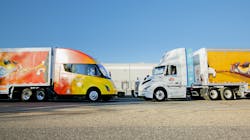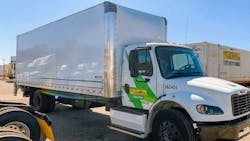Take time to test, before investing, in the future
The U.S. electrical grid isn’t ready to support the entire trucking industry. But that’s no reason not to get a feel for what the future of transportation is shaping up to be as regulators and others push the freight industry to be cleaner and more efficient.
“I’ve been in this industry 37 years, and clean and efficient has always been part of trucking,” Michael Roeth, executive director of the North American Council for Freight Efficiency, said while moderating a panel on the topic at Manifest Vegas on Feb. 1. “We work hard to move goods—not only on time and at cost—but we’ve always had this clean-and-efficient thing that drives us.”
It’s mostly large fleets that are getting deeper into zero- and near-zero emission technologies that are emerging in North America. PepsiCo, one of the largest private fleets in the U.S., made mainstream headlines late last year when it became the first fleet to get two electric Class 8 trucks from Tesla. Those EVs operate with others out of the company’s high-tech Frito-Lay facility in Modesto, California. PepsiCo is nearly finished transforming the 80-acre site with sustainable manufacturing, warehousing, and distribution technologies, it announced in January.
See also: Why fleets should care about ESG
But it took years of planning and testing—not to mention lots of government grant assistance—for the multinational food, beverage, and snack corporation to create the distribution center of the future. While most for-hire and private fleets in the U.S. are years away from decarbonization, it’s not too early to start testing and thinking about that future.
Why it’s important to plan for future technology now
Adam Buttgenbach, director of fleet engineering and sustainability at PepsiCo (No. 2 on the 2022 FleetOwner 500: Private), said fleets need to start planning out decarbonization years in advance. PepsiCo’s four-year project, which has already cut fleet greenhouse gas emissions by 91%, was supported by grants from California initiatives to curb climate change.
He advised fleets to look into electrification to get an idea of how much power they would need on-site to support their duty cycles. “Starting out with a single unit, getting a demo, and understanding the needs of the business, and then understanding as you go to scale what sort of impact on the site will be,” Buttgenbach said during a Jan. 31 Manifest panel on fleet autonomy and electrification in Las Vegas.
After creating an internal roadmap for PepsiCo’s fleet electrification, the company found that it needed more charging power. “We contacted major utilities and said, ‘We need two megawatts of power.’ They said, ‘That’s great. Come back in two years, we’ll have enough power for you,’” Buttgenbach recalled.
See also: Could the push for EVs be a wake-up call for modern infrastructure?
Its modern updates include replacing Frito-Lay’s diesel fleet with zero-emission and near-zero equipment, along with the fueling and charging infrastructure. The 500,000 sq. ft. facility includes three BYD 8Y electric yard tractors, six Peterbilt 220EV box trucks, 38 Volvo VNL compressed natural gas (CNG) tractors, 15 Tesla Semis, and four Tesla 750kW charging stations. It also features other environmentally friendly initiatives, such as a one-megawatt solar carport, electric forklifts, 2.7 megawatt-hours of onsite battery storage to reduce strain on the area’s electrical grid, and capabilities to charge up to 14 employee light-duty EVs at the same time.
The fleet executive advised other fleets to start site planning early and share future needs with utilities early. “I would definitely say, expect delays in getting new vehicles—especially in certain places.”
Patience could pay off as EV technology improves
Figuring out how zero-emissions equipment can fit into current-day fleet operations is one of the biggest challenges in trucking, according to Craig Harper, chief sustainability officer at J.B. Hunt Transportation.
“We’re anxious to test the vehicles as soon as we can and see how they’re going to perform and what their potential payback can be,” Harper said during a Feb. 1 panel at Manifest. “Because all of these solutions have got to be commercially viable. We can have all the greatest intentions and the best desires, but if the company is not sustainable in the long run, then we aren’t going to do anyone any good.”
See also: How to smooth the road to electric work trucks
Just getting testing done has been a challenge for J.B. Hunt, which is No. 4 on the 2023 FleetOwner 500: For-Hire list. He said his company is still waiting on EVs it ordered in 2017. And while the for-hire carrier has procured some EVs, it has struggled to set up charging infrastructure.
Despite the drawbacks, Harper said he’s excited to test more EV technology—and patience might pay off. “It does remind me of a lot of technologies, when they’re coming out, you continue to see multiple versions of that technology continuing to improve,” he said.
Current Class 8 electric truck batteries weigh more than 10,000 lb., which cuts cargo capacity limits. And the new technology costs a lot more than traditional diesel equipment. This is a good reason, Harper noted, to enter the EV space with prudence.
He recalled how expensive flat-screen TVs were when first introduced in the late 1990s. Most people didn’t pay the initial $15,000 asking price. “Most people probably didn’t buy them at $10,000. Probably not a lot at $5,000,” Harper said. “I jumped in, I think, at $2,200—and you felt foolish six months later when they were down to $1,600. Now you can get them for $600. Well, I think we'll see something like that in the EV space and that the cost of the batteries will come down.”
Harper expects, like HDTV technology, that EV batteries will become smaller, more affordable, and more powerful over time.
“I think it would be foolish—even if you could get your hands on the trucks and if you could get them charged—to buy them in large numbers right now would not be a prudent decision because whatever you buy today, I feel, will be inferior to the products that will be offered in the next 18 months to 24 months,” Harper advised. “And when you buy a truck, you buy it to hold for some time. And if people are correct in the world of EVs, things are gonna last even longer. So you sure don't want to buy the product that’s going to be outdated.”
Don’t wait to start testing EVs
But Harper said that fleets should still start testing EVs to see how they operate, to train drivers on regenerative braking, and technicians on how to maintain the zero-emission equipment. “We just need to continue to let it evolve,” he said.
But he did note that drivers in his fleet do like driving the EVs, which are quieter than internal combustion engine-powered equipment and easier to operate with no shifting required. “They like the fact that they don’t go home smelling like diesel,” Harper noted.
NACFE’s Roeth suggested fleet leaders be open-minded about zero-emission technology. “Go experience it,” he said. “It’s easier to do than you think. Rent a Tesla or an electric car just to get the experience.”
About the Author
Josh Fisher
Editor-in-Chief
Editor-in-Chief Josh Fisher has been with FleetOwner since 2017. He covers everything from modern fleet management to operational efficiency, artificial intelligence, autonomous trucking, alternative fuels and powertrains, regulations, and emerging transportation technology. Based in Maryland, he writes the Lane Shift Ahead column about the changing North American transportation landscape.



